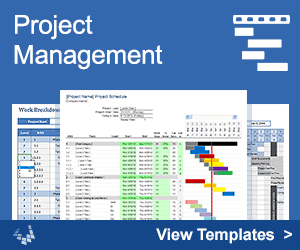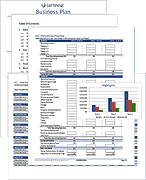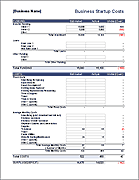SWOT Analysis Template
This Page (contents):
A SWOT Analysis is a structured brainstorming and evaluation tool used to identify your internal Strengths and Weaknesses and external Opportunities and Threats. You can use a SWOT analysis prior to starting a business, to evaluate and grow your current business, prior to launching a new product, or to improve a system or process. You can also use it on a personal level to advance or change your career and improve your financial health.
SWOT Analysis Template
for Excel, Word, Google Sheets and PDFDownload
Over 40,000 downloads!
⤓ Excel⤓ Google Sheets
License: Private Use (not for distribution or resale)
Authors: Jon Wittwer and Jim Wittwer
Description
This SWOT analysis spreadsheet will help your analysis and discussion stay organized and efficient. There are a variety of layouts depending on your preference. They can be printed and filled out by hand, or you can display and edit the worksheet in real-time using a projector during your group discussion. The numbers for each area can be used to organize your team's responses from most important to least. The "action items and goals" section helps you put your results into action.
The information, steps and suggestions listed below will help you use the SWOT analysis template effectively. The references listed at the bottom of the page (especially [1]-[4]) were useful to us in preparing this material, and may also help you learn more about how to apply a SWOT analysis effectively in your business.
SWOT Analysis Definition
What is SWOT Analysis?
A SWOT Analysis is a structured team brainstorming and evaluation tool used to identify your internal Strengths and Weaknesses and external Opportunities and Threats. The analysis helps you see the current state of your business or product, and then make informed goals and strategic plans for future success. You can also use it on a personal level to analyse your career or finances.
S: Strengths (Internal)
Strengths are the key things you do well that give you an advantage over the competition. Continuing to remember, build upon and augment your strengths may help maintain a competitive advantage.
W: Weaknesses (Internal)
Weaknesses are the things you don't do well, or as well as the competition, that may hinder your success and growth. Identifying your weaknesses will allow you to make goals to minimize/mitigate them, turn them into future strengths, and determine if they expose you to external threats.
O: Opportunities (External)
Opportunities are changes occurring externally to your business that you could take advantage of, such as changes in regulations, social changes, or new products that don't currently exist. Opportunities help you identify areas where you can grow - where to focus your time and resources.
T: Threats (External)
Threats are any external factors that could have a negative impact, such as trends in the market and society or government regulations. These factors are likely out of your control, but your team should keep an eye on them and plan ways to mitigate their effects.
Important Keep in mind that Strengths and Weaknesses are internal, while Opportunities and Threats are external - confusing internal and external factors is a common confusion in a SWOT analysis. For example, an action you take to eliminate or improve a weakness is not an opportunity. It is simply an action that you will take related to your listed weakness.
How to prepare for an effective SWOT analysis
Identify the Purpose
You can perform a SWOT analysis on your business as a whole or focus on specific aspects, products, or processes. The clearer the purpose, the more effective and actionable the SWOT analysis results are likely to be. The purpose will help determine what preparation is needed (such as who to involve, what questions to ask, etc.)
Some examples of what you would use a SWOT analysis for are:
- Assessing where your company stands today
- Launching a new product
- Deciding where to focus research and development
- Improving a specific process
Research and Prepare
Now that you have a purpose, collect important information prior to the group discussion. Get feedback from leaders, employees, and customers regarding your internal Strengths and Weaknesses. Research your industry, market, and competitors to gather information needed for external Opportunities and Threats.
The SWOT analysis does not need to happen in a single meeting. You may find that you need to do more research and get more feedback after a preliminary discussion.
Who should participate in a SWOT analysis?
The more perspectives you can include related to your analysis the better. At the minimum you should involve your core team - those who can take action on the results.
If any of your team members are not familiar with SWOT Analysis, you should brief them on the purpose and process prior to the meeting so that they can come prepared with information and incites. Having them review the definition of the four areas listed above can be especially helpful.
What questions should be asked during a SWOT analysis?
The moderator of the discussion should try to come up with a few questions for each of the four areas that can help guide and inspire the discussion. Below are some sample questions to get you started. A few of these are included in the SWOT analysis templates.
Strengths
- What do our customers love most?
- What are we more efficient at?
- What can we do for less money?
- What can we do in less time?
- What do we do better than our competitors?
- What makes us stand out?
Weaknesses
- Where do we lack efficiency?
- Where are we wasting money?
- Where are we wasting time and resources?
- What do our competitors do better?
- What are our top customer complaints?
- Where do we lack expertise?
Opportunities [keep in mind these are growth areas]
- What is missing in our market?
- What could we create/do better than a competitor?
- What new trends are occurring?
- What new technology could we use?
- What openings in the market are there?
- How/where could we grow?
- Do our strengths open up new opportunities?
Threats
- What changes are occurring in our market's environment?
- What technologies could replace what we do?
- What changes are occurring in the way we're being discovered?
- What social changes could threaten us?
- Are there any threatening government policies or regulations?
- What outside resources and companies do we depend on?
- Do any of our weaknesses expose us to additional threats?
How to run an effective SWOT analysis discussion
Provide a Brief Overview: Some of the team may be less familiar with the process, so start the discussion with an explanation of the purpose, how the discussion will proceed, and what you hope to accomplish by the end of the meeting.
Discuss and Brainstorm: The first part of the analysis involves discussing each of the four areas and writing down your team's responses along the way. You may want to use brainstorming techniques during this part of the discussion. Keep the discussion fluid, not focusing for too long on one topic.
TIP Unless you want to do everything on a white board first, you can edit the SWOT Analysis Template within Google Drive in real time during your discussions. You should try to have an experienced computer user edit the document so that you don't distract your discussions with technical problems.
Analyze and Rank: After your team has come up with multiple points for each of the four areas, you can discuss the items in more detail. You may want to sort or rank them based on importance and priority.
TIP If you are using the SWOT Analysis Template, you can edit the numbers to the left of each item and then use Excel's sort feature to quickly reorder your individual lists. Select the group of cells within the category (including the numbers), then go to Data > Sort & Filter > A>Z (Smallest to Largest)
What to do after your SWOT analysis
Make Goals and Take Action.
Completing a SWOT analysis is just the first step. It is important to then take the time to identify potential courses of action. This is why our template includes an Action Items & Goals section at the bottom which samples questions like these:
- Which opportunities should we pursue? How can we use our strengths to help us succeed?
- Which weaknesses can be worked on to help maximize success?
- What threats should we learn more about or monitor more closely? What strategies can we put into place to be prepared for threats?
TIP A great way to keep the results of the analysis on everyone's mind is to print out the completed analysis and put it in highly visible and high traffic areas around the office.
References and Resources
- [1] SWOT Analysis at Wikipedia.org - An overview of what a SWOT analysis is, its origins and uses, plus additional references.
- [2] Overview & Articles About SWOT Analysis at sciencedirect.com - A great collection of articles, papers and books related to using a SWOT analysis effectively along with real world examples.
- [3] How to Perform a SWOT Analysis at onstrategyhq.com - Great article and video that explains how to effectively perform a SWOT analysis and what to avoid. Includes many other related business strategy videos.
- [4] SWOT Analysis at MindTools.com - Another useful article, and they provide a downloadable PDF worksheet. Including sample questions in the worksheet is a great idea, and we have done something similar with our own list of questions in our templates.
- St. Cloud State University's SWOT Analysis at stcloudstate.edu - A SWOT analysis example performed by the university for their strategic plan.







